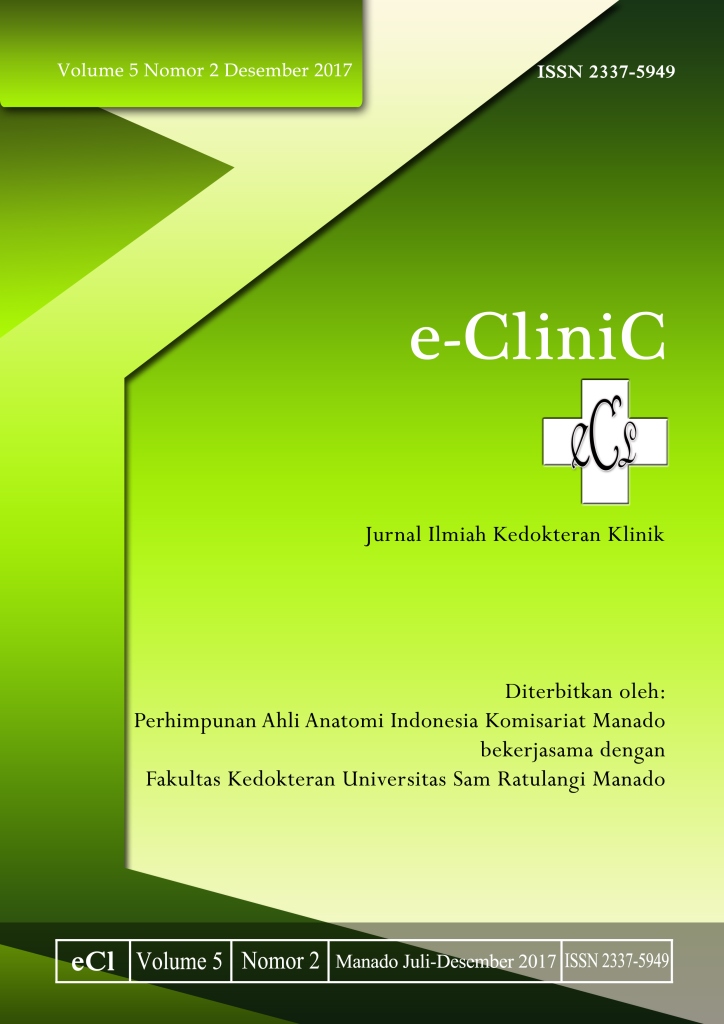Angka Keberhasilan Terapi Reperfusi pada Pasien ST Elevasi Miokard Infark
DOI:
https://doi.org/10.35790/ecl.v5i2.18279Abstract
Abstract: ST-Elevation Myocardial Infarction (STEMI) is a kind of acute myocardial infarctions (AMI) with a high rate of mortality. Patients with STEMI are usually treated with reperfusion therapy consisting of primary percutaneous coronary intervention (primary PCI) and fibrinolytic therapy. This study was aimed to determine the success rate of reperfusion therapy in patients with STEMI at Prof. Dr. R. D Kandou Hospital Manado from January to December 2016. This was a descriptive observational study with a retrospective approach. Samples were patients with STEMI treated with reperfusion therapy at Prof. Dr. R. D Kandou Hospital Manado from January to December 2016, obtained by using consecutive sampling method. There were 73 patients in this study consisted of 82.2% of males and 17.8% of females. Most patients were >60 years old; 39.0% treated with primary PCI and 43.8% with fibrinolytic therapy. According to duration of therapy administration, most primary PCI were given at >90 minutes (80.5%) and fibrinolytic therapy at >30 minutes (75%). The success rate of primary PCI was higher in patients treated at ≤90 minutes (100%) compared to patients treated at >90 minutes. Moreover, the success rate of fibrinolytic therapy was higher in patients treated at ≤30 minutes (100%) compared to patients treated at >30 minutes (75%). Ventricular tachycardia (34.6%) was the most common type of reperfusion arrhythmia. Conclusion: The success rate of reperfusion therapy (primary PCI and fibrinolytic) in STEMI patients was higher if it was administered according to the optimum recommendations and targets.
Keywords: STEMI, success rate of reperfusion therapy
Â
Abstrak: ST elevasi miokard infark (STEMI) merupakan jenis infark miokard akut (IMA) dengan mortalitas yang tinggi. Penatalaksanaan pasien STEMI dilakukan dengan terapi reperfusi yang terdiri primary percutaneous coronary intervention (primary PCI) dan fibrinolitik. Penelitian ini bertujuan untuk mengetahui angka keberhasilan terapi reperfusi pada pasien STEMI di RSUP Prof. Dr. R. D. Kandou Manado periode Januari-Desember 2016. Jenis penelitian ialah deskriptif observasional dengan pendekatan retrospektif. Sampel penelitian ialah pasien STEMI yang menerima terapi reperfusi, dirawat di RSUP Prof. Dr. R. D. Kandou Manado periode Januari-Desember 2016, yang diperoleh dengan teknik consecutive sampling. Dari total 73 pasien STEMI didapatkan pasien berjenis kelamin laki-laki (82,2%) lebih banyak dibandingkan perempuan (17,8%). Kelompok usia terbanyak ialah >60 tahun; 39,0% untuk terapi primary PCI dan 43,8% untuk terapi fibrinolitik. Waktu dilakukannya terapi reperfusi terbanyak dengan waktu terapi >90 menit untuk terapi primary PCI (80,5%) dan >30 menit (75%) untuk terapi fibrinolitik. Angka keberhasilan terapi primary PCI <90 menit lebih tinggi (100%) dibandingkan dengan terapi primary PCI >90 menit (96,6%), dan angka keberhasilan terapi fibrinolitik <30 menit lebih tinggi (100%) dibandingkan dengan terapi fibrinolitik >30 menit (75%). Jenis aritmia reperfusi ditemukan terbanyak ialah aritmia ventrikel takikardi 34,6%). Simpulan: Angka keberhasilan terapi reperfusi (primary PCI dan fibrinolitik) pada pasien STEMI lebih tinggi jika dilakukan tepat waktu sesuai dengan sasaran terapi optimal.
Kata kunci: STEMI, angka keberhsilan terapi reperfusi.
Downloads
How to Cite
Issue
Section
License
COPYRIGHT
Authors who publish with this journal agree to the following terms:
Authors hold their copyright and grant this journal the privilege of first publication, with the work simultaneously licensed under a Creative Commons Attribution License that permits others to impart the work with an acknowledgment of the work's origin and initial publication by this journal.
Authors can enter into separate or additional contractual arrangements for the non-exclusive distribution of the journal's published version of the work (for example, post it to an institutional repository or publish it in a book), with an acknowledgment of its underlying publication in this journal.
Authors are permitted and encouraged to post their work online (for example, in institutional repositories or on their website) as it can lead to productive exchanges, as well as earlier and greater citation of the published work (See The Effect of Open Access).







